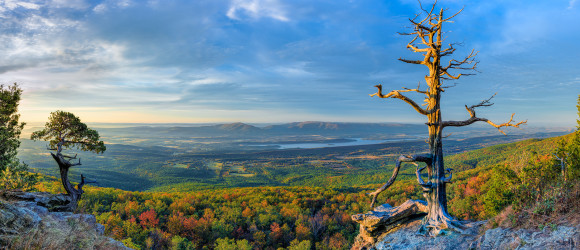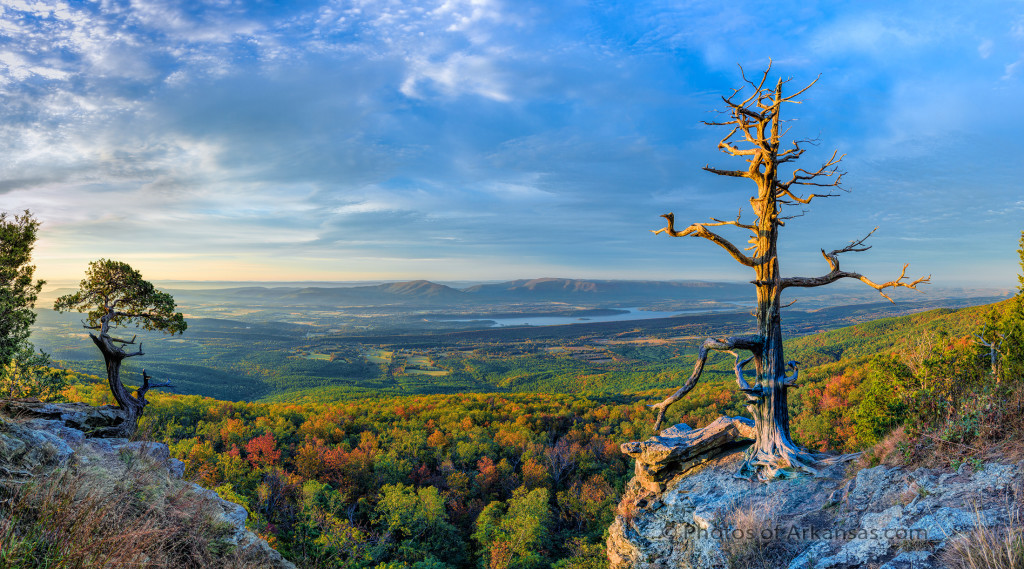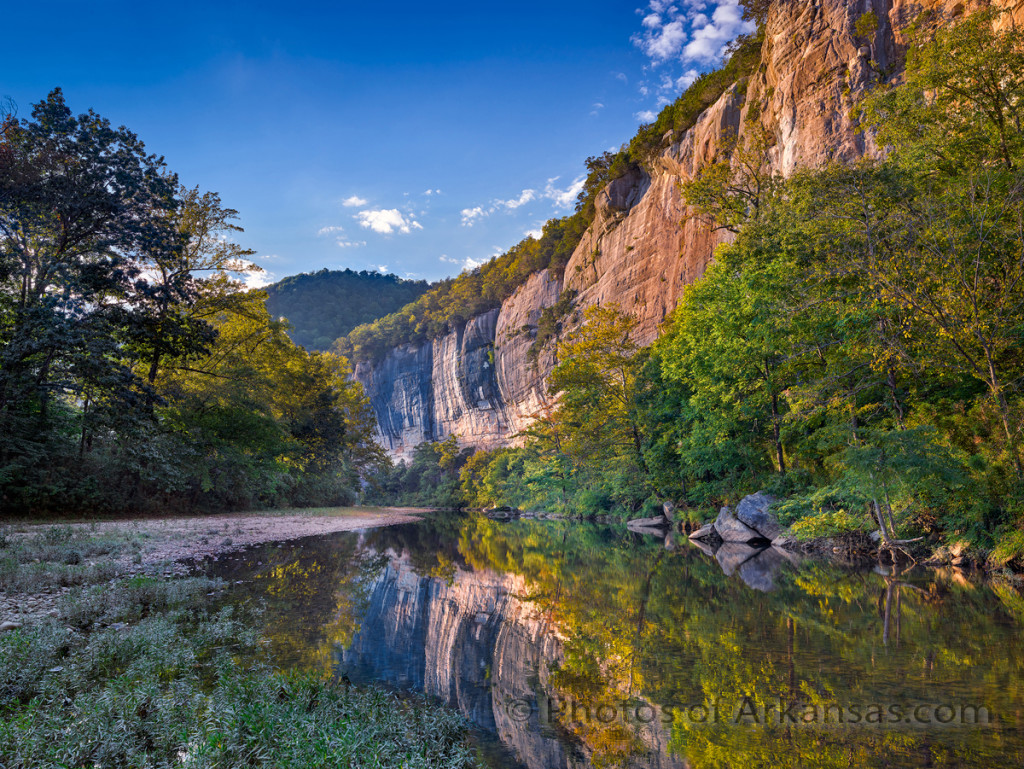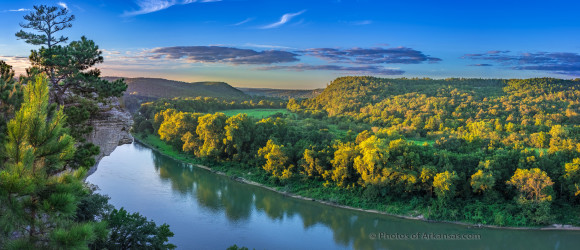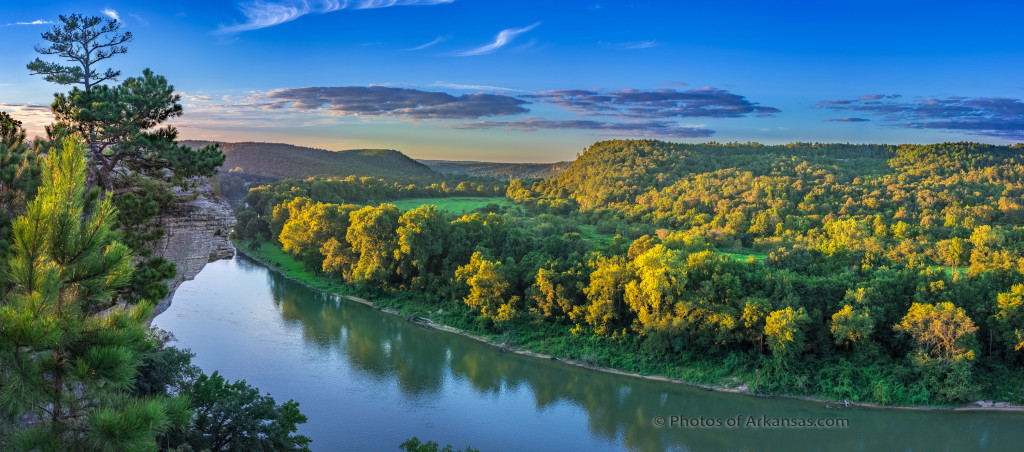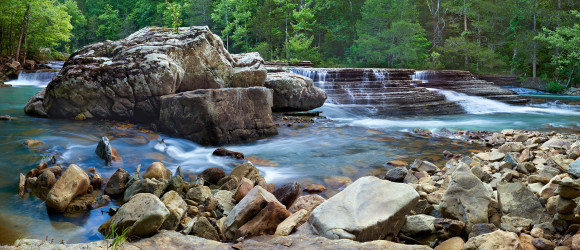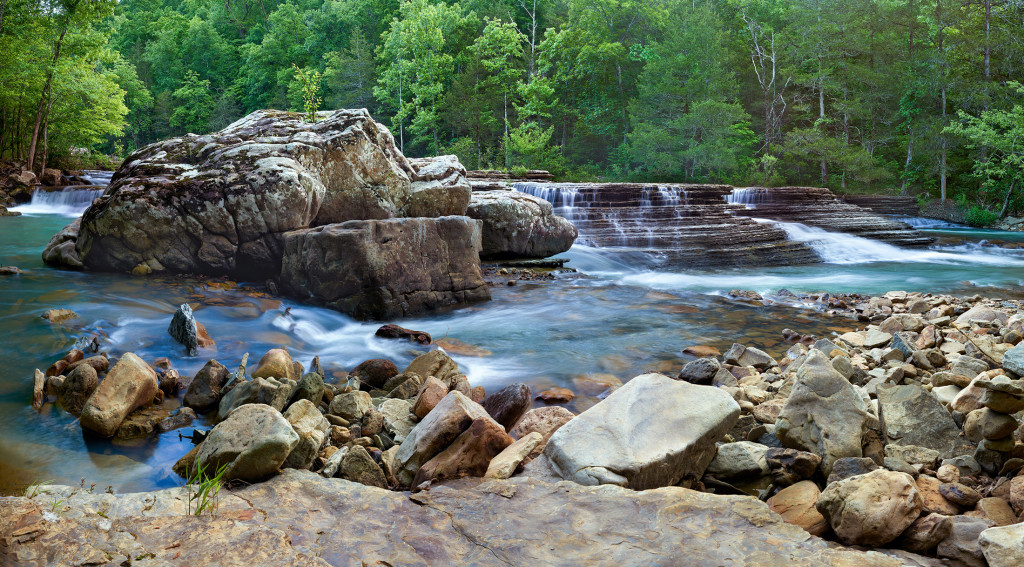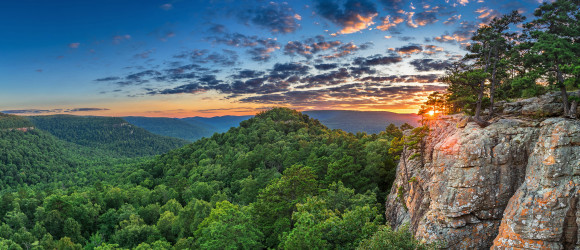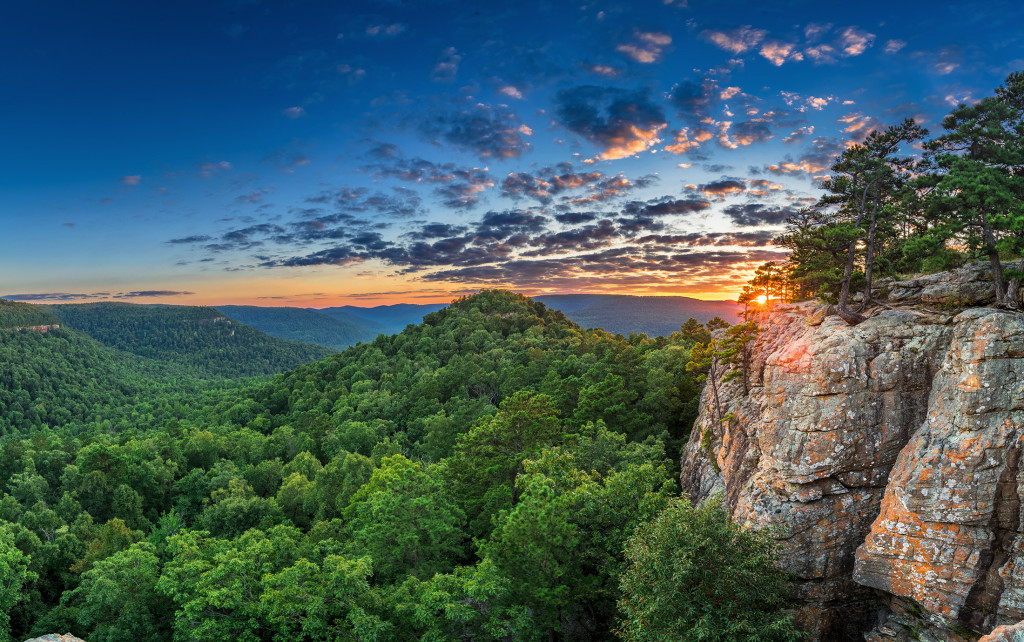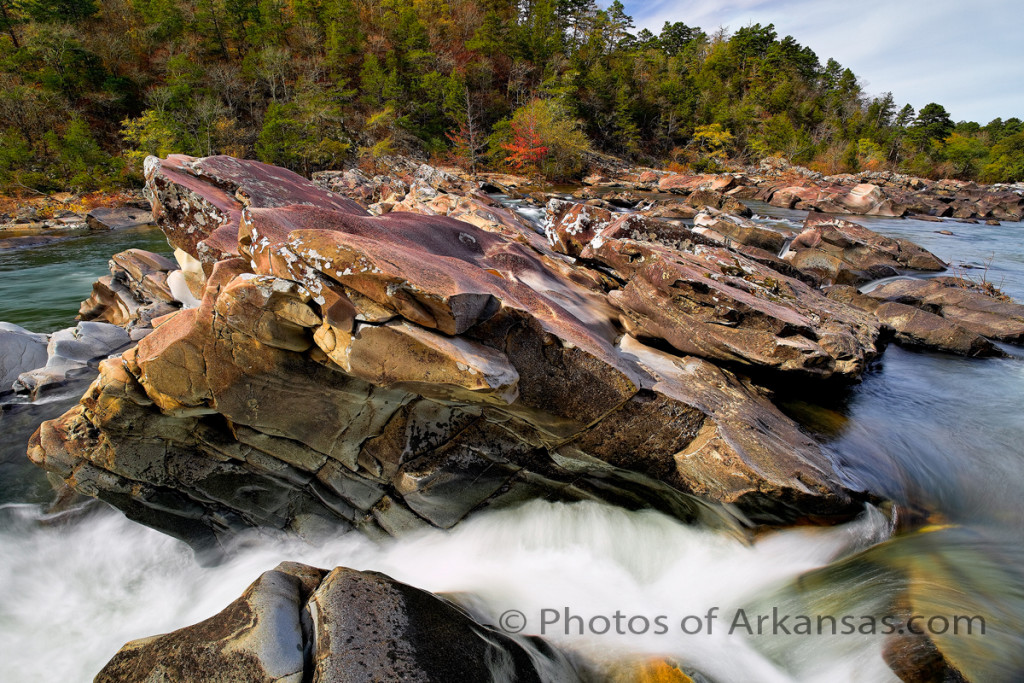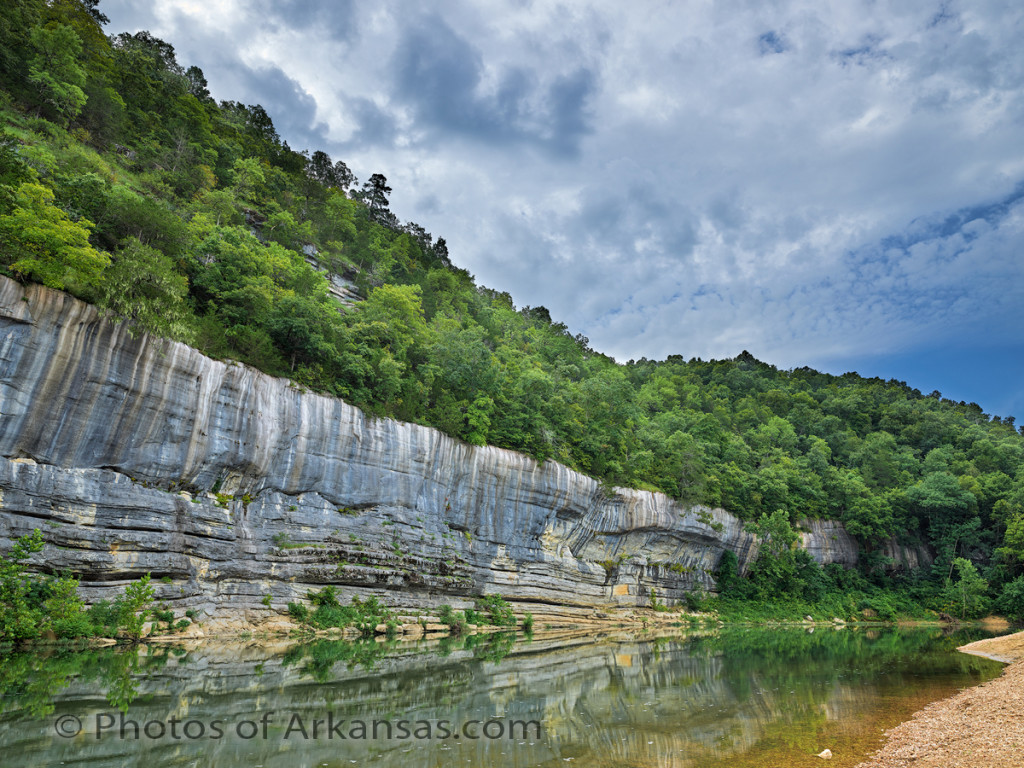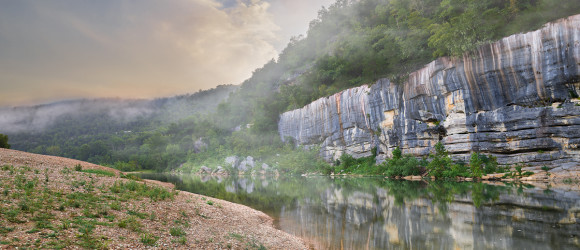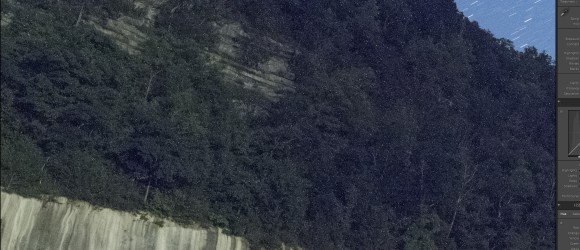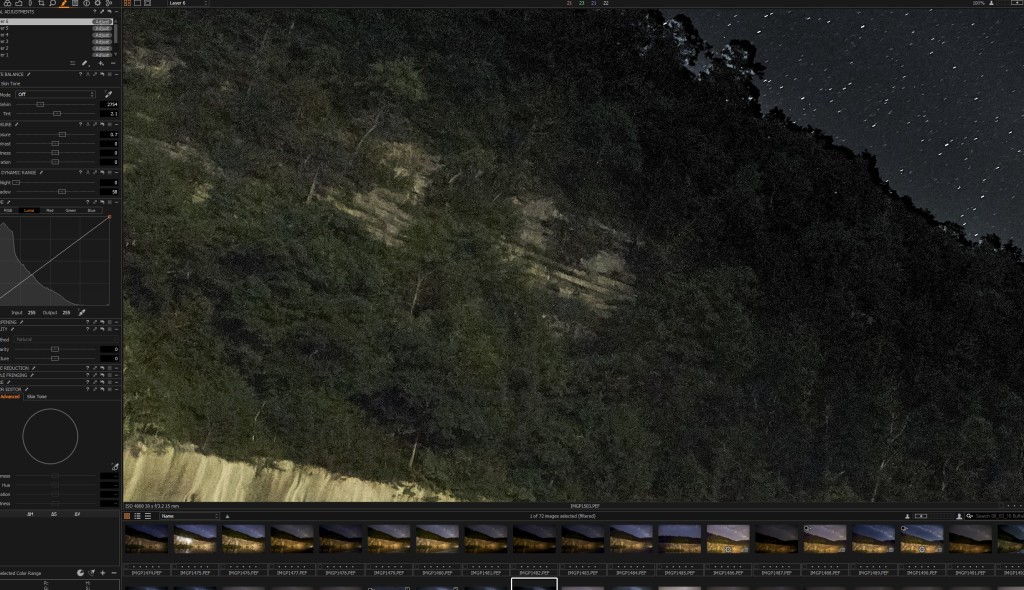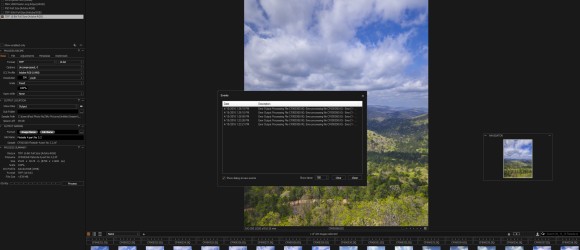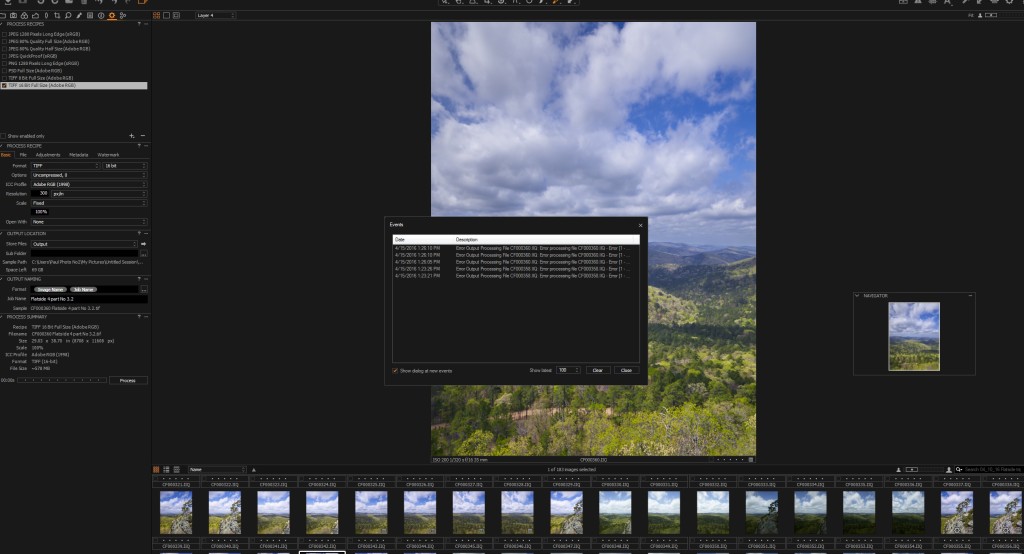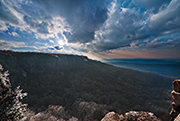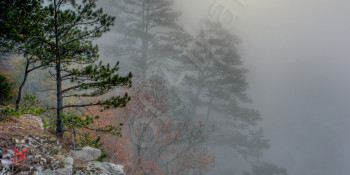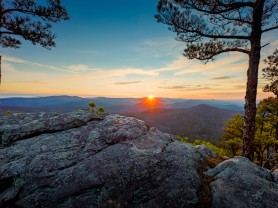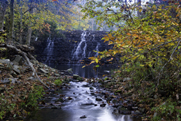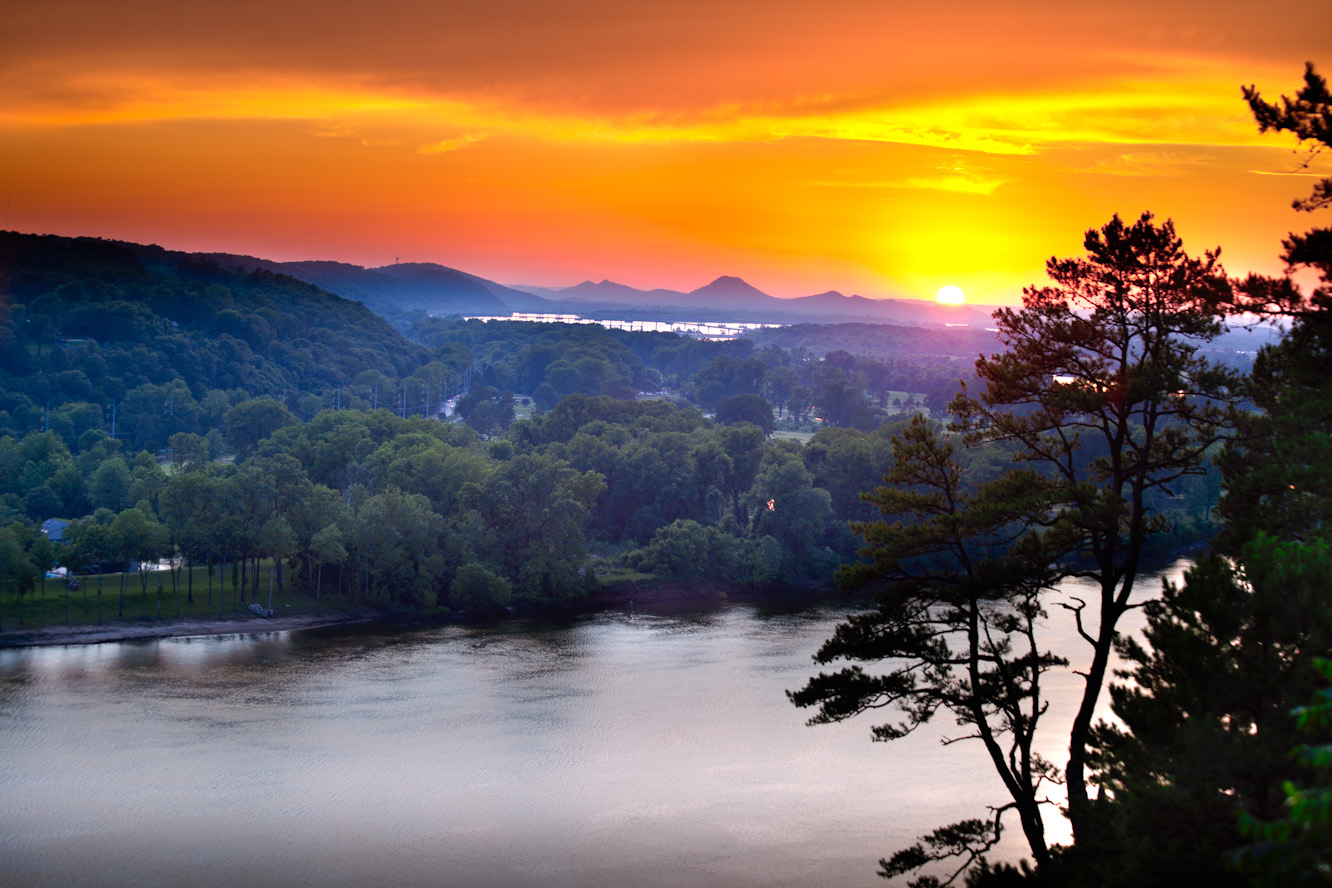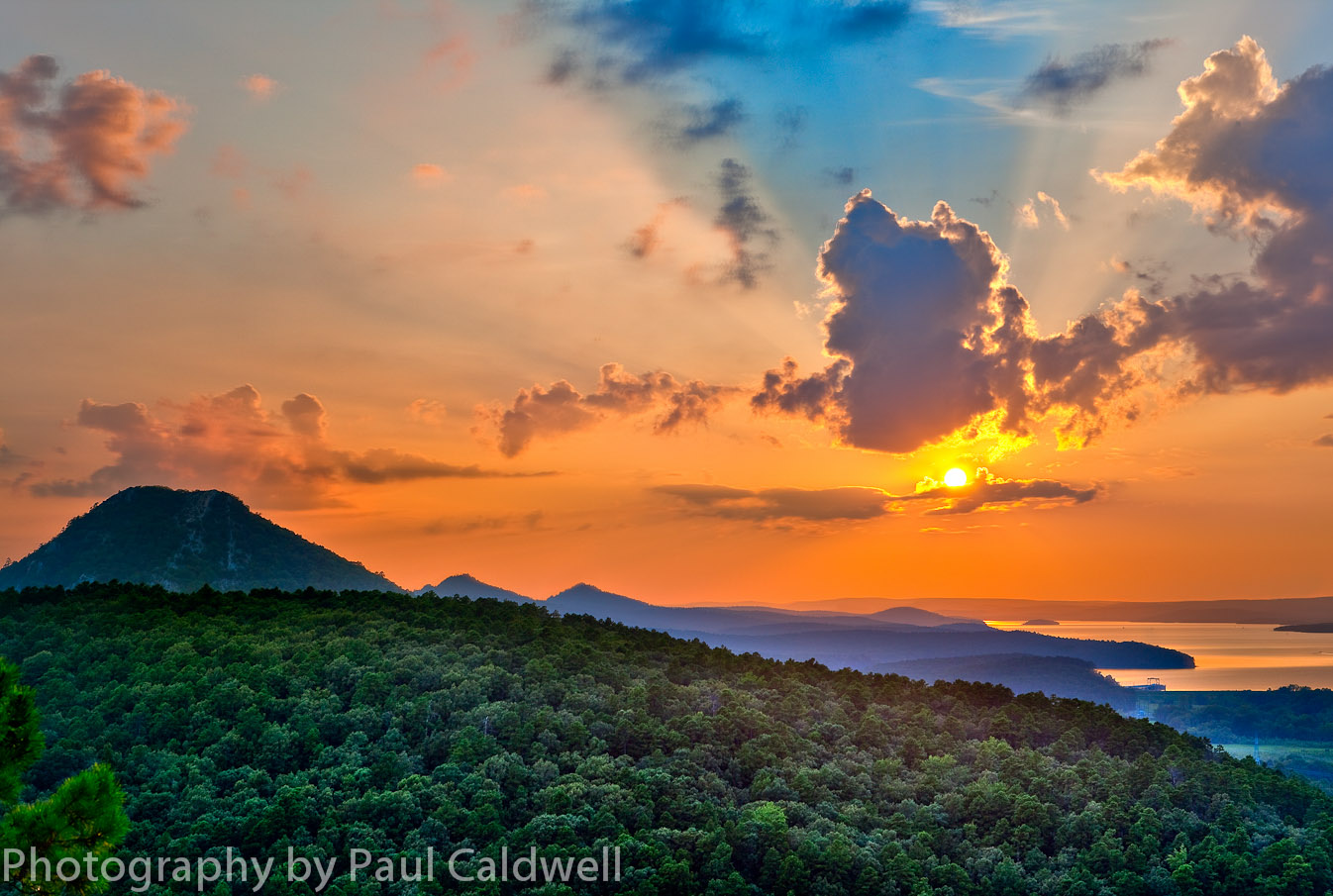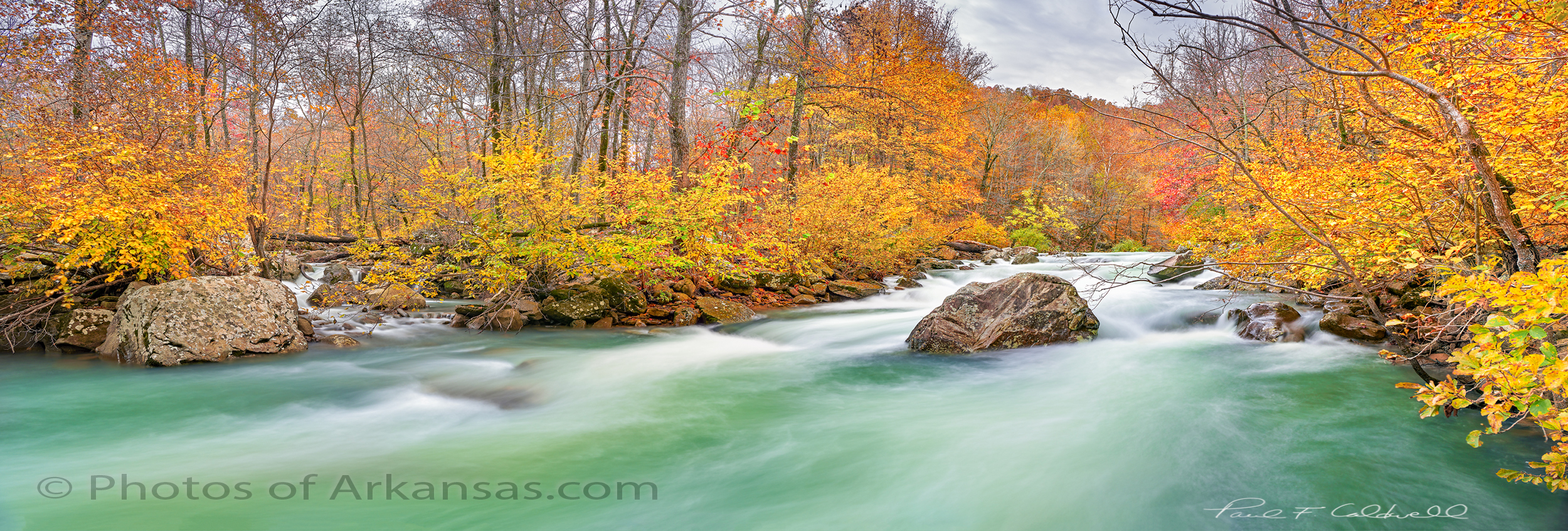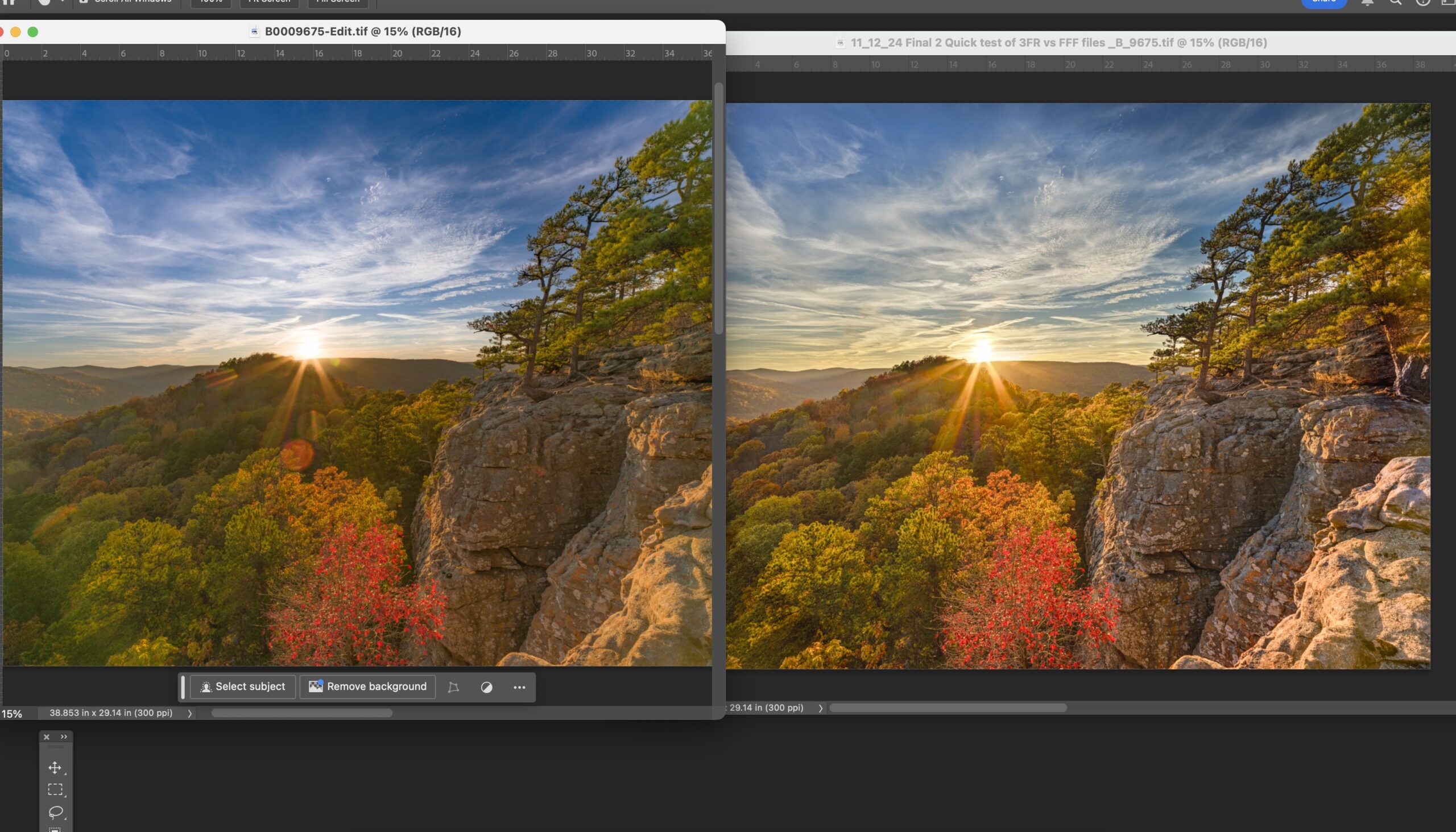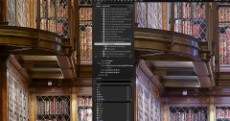10/14/16 Featured Arkansas Landscape Photography–Sunrise from the summit of Mt. Magazine
Taken with a Nikon D810 and 14-24 Lens, @ 24mm in 3 vertical shots, stitched together in Lightroom
The view from the summit of Mt. Magazine offers some amazing vistas, and one of the best is looking out to the due south towards Blue Mt. Lake and Blue Mountain behind it. This shot was taken last year, in late October and I was able to catch the rising sun hitting the rock and old tree in the foreground. Mt. Magazine is the highest place in Arkansas and has a lot to offer the visitor. There is a wonderful lodge where you can spend the night and enjoy a great meal after hiking around on some of the trails. The area is also a favorite for rock climbing and hang gliding.
I like to work this particular spot on Mt. Magazine year round, but the spring and fall are my favorite times. The sun will only come into the frame during December and January, but you can still get great photographs during the rest of the year. The play of light is amazing here.
Mt. Magazine’s summit is 2,700 feet high, and is the highest place in Arkansas. You can see for many miles off in pretty much any direction. The lodge offers a higher vantage point so when you visit make sure stop by.
The view from Mt. Magazine’s north side is just as impressive, so make a point of driving over to that side also. There is a one way drive which has several pull outs for viewing. During the fall you can expect a lot of traffic and a bit of congestion, especially during the weekends. The lodge will be booked up a year in advance for the best dates in the fall so plan accordingly.
This image was taken with aid of a tripod, in 3 vertical segments with a Nikon D810 and 14-24 lens. I used the 24mm focal length and F8 with the base ISO. I did not use a polarizer since I was panning across the scene and knew that would cause problems with composition later. I used Lightroom to work on the raw files, and also to make the panorama. The fall colors were just a few days before peak when this image was taken.
09/27/16 Featured Arkansas Landscape Photography–Late afternoon at Roark Bluff Buffalo River
Taken with an Phase One IQ100 @ 35mm LS lens, ISO 50 and circular polarizer for both sky and cutting glare on leaves.
This is the time I like to start working the Buffalo River, as fall is just around the corner, and as can be seen in this shot, is actually started on the Buffalo.
The Buffalo River at Roark Bluff is one of my favorite spots to photograph and I work it as often as I can, but the drive up and back has started to slow me down. I was hoping for a few clouds to help break up the sky and there were there, but only towards the far side. The sun was playing hide and seek most of the afternoon, and when the sun finally came out the wind started to blow ruining the reflection. There are a lot of spots on the Buffalo to catch a reflection but this is my favorite.
This was taken in one exposure, something I never could have done before with a Phase One CCD back, the 100MP CMOS chip does have some excellent range. This type of shot is one of the most difficult as you are working directly at the brightest part of the subject. This means that anything not illuminated by the sun (in this case the left side of the river) will be in deep shade. You want enough exposure to be able to pull this area up some and not leave it black, but you also have to be very care not to blow out the sky, especially the left side. The use of a polarizer was needed more for the glare on the leaves to the right. Without it the colors would not have been as nice and clean, you have to be careful when working such a scene to see that you keep the polarized effect as even as possible on your sky, so you may need to try a few exposures.
After waiting for almost an hour, the sun popped back from behind the clouds and the wind died down long enough for this shot.
09/22/16 Featured Arkansas Landscape Photography–Sunset at Calico Rock on the White River
Taken with a Fuji X-Pro2, ISO 400, 35mm F2.0 lens, at F9, Panorama taken in 4 vertical images, each segment 3 exposures for a total of 12. Worked up in Adobe LR
Calico Rock, is one of the more interesting spots on the White River in Arkansas. You can drive right to it and when you arrive, you have a sweeping view of one of the larger bends of the White River. The bluff is about 150 feet above the river and you really cannot see much of the bluff itself. However there is one vantage spot where you can look to the west an there is a small out cropping that adds a lot to the photograph. Many call this “little Hawksbill Craig” after the larger feature up on the Buffalo River. However I just like to photograph the valley. If you look downstream, you will see the town of Calico Rock on the left hand bank of the river.
This shot was taken in a series of vertical segments, 4 total and for each segment I exposed 3 images. I then worked each of the 3 shots into a HDR balanced image in Lightroom. After that, I took the final 4 images and created a panorama. It’s very important to realize that you do not want to do any work on the individual HDR segments before the panorama merge. I prefer to use the boundary warp feature of Lightroom also as most of panoramas in taken like this will only work in a spherical format and thus your top and bottom edges will have some problems.
The Fuji X-Pro2 makes this very easy with it’s automatic bracketing shutter, where you only have to press the shutter once to fire all 3 brackets.
I have found that Fuji made some very good positive changes to the dynamic range of the X-Pro2 as can be seen in this image. Also Adobe must have done a bit of tweaking to their X-trans conversion for the X-Pro2.
You can get to Calico Rock from Little Rock, in about 3 hours and the drive is quite beautiful.
09/21/16 Featured Arkansas landscape photography–6 finger falls on Falling Water Creek
Taken with a Phase One IQ100 and 35mm LS lens, 2 part horizontal pano. Taken in 4 shots to merge later for foreground and background in Helicon Focus
Arkansas has many great streams to hike but one of the best is Falling Water Creek, which is well named as it has a large number of waterfalls it’s entire length before emptying into Richland Creek. Falling water creek has an upper and lower half, and some of the best spots to photograph are on the lower half. There you will find creek wide ledges like 6 finger falls. 6 finger falls, named for the cut outs the creek has made in the ledge, is quite a wonder. It offers great photographic opportunities year round but is best in the fall and spring. You will be lucky to find any water in the creek in the fall and if you do consider yourself lucky. The banks are lined with deciduous trees that offer a great display of fall color.
You will also like the fact that for most of it’s length, falling water creek has a forest service road that parallels it’s length and so offers quick access. This of course means in Arkansas you can expect to find all types of folks here on a good weekend, so plan your trip during the week if at all possible. The forest road is number 1205. Heading due north on the road, falling water creek will be on your right for the upper half, and then after you cross it on the left. For a portion of it’s length, the Ozark Highland trail is just above the road on the right, below the bridge. This is great day hike also.
Make sure to include a trip to the mouth of falling water creek at Richland Creek campground. Richland is the crown jewel of creeks in Arkansas and is also protected as a Wilderness Area, so you can enjoy a day without hearing a 4 wheeler.
09_10_16 Featured Arkansas Landscape Photography–Sunset from Sam’s Throne
Taken with a Pentax K1 in three vertical segments of 4 exposures each, LR used for HDR conversion to 3 vertical segemnts, Stitched in Lightroom into single 3 part panorama, ISO 100, F11 Pentax 15-30mm Lens @ 17mm.
In the late summertime of September, the Arkansas skies can surprise you. Many times you will find a pure blue sky about 1 hour before sunset, only to see some light cloud cover roll right as the sun sets. On this evening, I was able to catch some of this at Sam’s Throne. I had hoped to have clear skies as I was going to stay for a while after dark and work the Milky Way with the Pentax Astrotracer feature, but the sunset was a added bonus for sure.
Sam’s Throne is one of the premier climbing spots in Arkansas due to the bluffs that run for over 1 mile. The rock is a type of sand stone and and during the sunset will take on an orange color. The rocks are also covered with a bright orange lichen, one that I have really only found in this part of Arkansas. So at the times of bright and intense light, the rock of the bluffs can really stand out. I like to work from a spot where you can catch both the true throne (the smaller peak in the center of the image) and pick up the bluff line. During the late summertime the sun will set just off the bluff through the trees and can add a wonderful effect as it will accent the pines at the top of the bluff line.
This photograph, is quite a composition as it was taken in 12 frames, 4 from each station in a short panorama. I then blended each segment with Lightroom’s HDR tool into a 3 dng files, that were then combined into a 3 part panorama. This allowed me to capture both the brightest highlights in the shot and keep the noise out of my shadows. The green of the trees was just perfect on this evening, just a bit of yellow starting to show up in the tops. There were a few trees already starting to go into a full color display, but these were more towards the top of the bluff.
You can pick any of hundreds of spots to work at Sam’s. In this shot, you can see on the left side the same bluff line as it has worked around the hillside. I sometimes like to work from that spot also as you can still capture the sunset and you have a different perspective of Sam’s.
It takes about 2.5 hours to get to this part of Arkansas from Little Rock, and the drive north from Russellville is well worth it, especially in the Spring and Fall when the trees take on very unique colors.
08/22/16 Featured Arkansas Landscape Photography–The washing machine on the Cossatot River Southwest Arkansas
Taken with a Canon 5D MKII and 24mm TS-E lens, with a CL-PL and ND 0.9 filter installed, exposure time approximately 1.5 seconds.
You can find some excellent photographic opportunities on the Cossatot River, along with some of the best Arkansas whitewater. Go down there anytime the river is running over 500 cfs (cubic feet per second) and you can expect to see a lot of kayakers running the falls.
I like to hike the 6 falls when there is about 100 to 400 cfs max running the river. This allows you to make easy crossings and you can still get down close enough to the river to get some great angles. The river will run muddy right after a rain storm due to the massive amount of timber clear cutting in the area, so plan on heading down a day or so after a big rain.
You can easily hike down the entire left side (left side facing downstream) and there are 6 separate ledges which the river cuts through. Each has a unique rapid and name:
Cossatosser, Eyeopener, BMF, The Washing Machine, Whiplash, and Shoulder bone.
If you make it down there, remember that the sun will move across the river from left to right so the some of the best photograph will be early in the morning. The falls run due south. There are a ton of huge rocks that line the river and each of them will allow you a spot to setup for some great photos. The washing machine, featured in this photo has some of the best angles up on top of the ledge, but you need to cross over right above this small rapid. If the river is running too high, this can easily become a hazard so be careful. All the rocks are covered with slim moss and will be slick.
The rock is sandstone or something close and in the sun will take on a wonderful red-orange hue so try to make it on nice sunny day.
08/21/16 Featured Arkansas Landscape Photography–Storm Clouds over Buffalo Point, Buffalo National River Arkansas
Taken with a Phase One IQ100 and Phase One XF/35LS lens, at ISO 100, F12 for 1/40 of a second on tripod, single exposure.
This was taken back in early August 2016 on the Buffalo River in Northwest Arkansas. This part of the river is known as Buffalo Point, and is one of the more popular spots on the river. It features one of the larger campgrounds on the Buffalo along with hundreds of miles of hiking trails. Within 9 miles of Buffalo Point, you can driver over to Rush Arkansas which is an old mining town which dates back to around 1917. There is not much left standing at Rush, but it still offers some nice hiking.
This image shows just how fast conditions can change. I walked down to the river before sunrise. This particular bluff is on the east side of the river, thus will not get any sunlight until mid day. It’s a great spot to catch a sunset if the clouds lineup, but you also can expect to find hundreds of people wandering around the beach which just add confusion to both the scene and water. On this morning I was hoping to catch the area to myself, and for about a magic 40 minutes I had just that. There was almost no wind blowing, so I also was able to get a very nice reflection of the bluff. This bluff is about 80 feet tall and the face about 35 feet or so and it’s one of the classic Ozark bluffs made 100% from limestone so you can expect to get some interesting color from the rock.
I worked the area up and downstream, but this spot was the best as a early morning storm rolled in. When I first arrived there were no clouds in the sky at all just a bit of river fog, but within 30 minutes the top of an old thunderhead came over the river and really added to the shot. The heat and humidity were intense but the photographic opportunities were excellent.
This is single exposure from an IQ100 Phase One digital back and I have to say that the overall dynamic range of this back is impressive. The ability to finally cover a shot with just one exposure, knowing that you have room to work up shadows without a bracketing series of exposures is a great feature and long overdue from Phase One.
08/20/16 Featured Arkansas Photography–Early morning at Buffalo Point, Buffalo National River
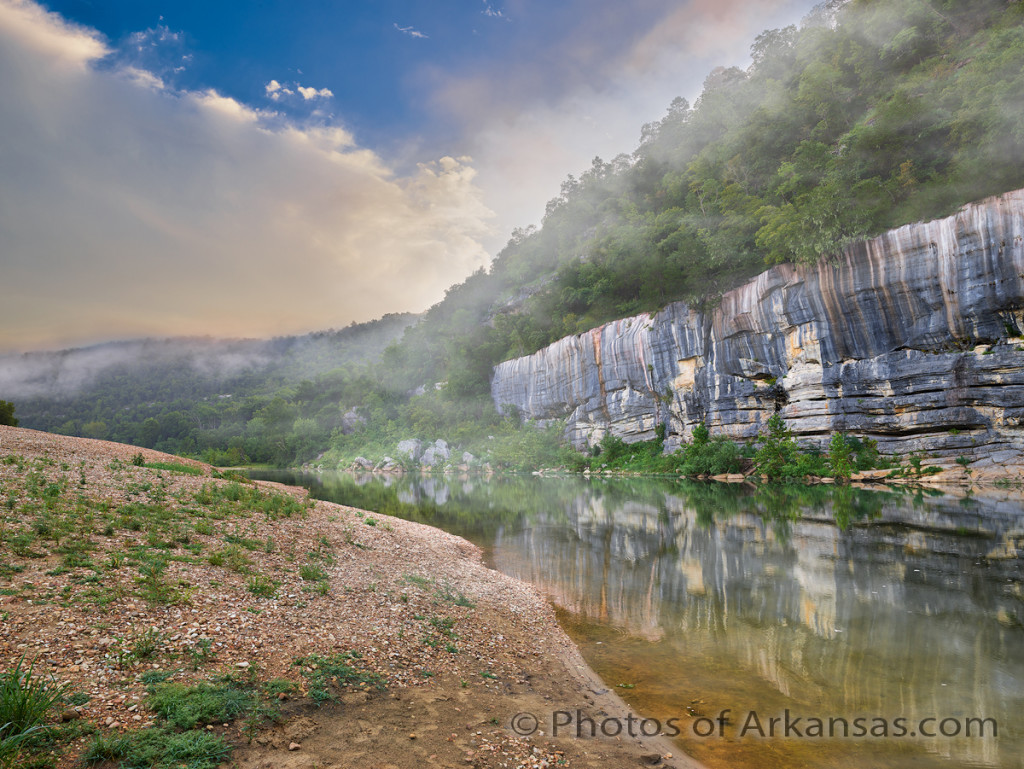
Early mornings are some of the best times to photograph the Buffalo River. This is from Buffalo Point.
Taken with a Phase One IQ100 and 35LS lens, no filters @ ISO 100 for 1/40th of a second F12 and Phase One XF.
While on a trip to the lower Buffalo River, I was able to spend the night at Buffalo Point Campground. This is the first campground that was built on the Buffalo, and dates back to the WPA and CCC days of the late 1930’s in Arkansas. Here you are pretty low down on the river as there is only about 20 or so miles left before the river runs into the White River. Buffalo Point is a very popular spot on the river as it has an excellent campground, and there is a great swimming hole below the large bluff on the far side of the river. From here you can take a quick float down to Rush which is about 8 miles or do down river. It’s a great float to take in the fall to enjoy the fall colors as most often there will be enough water for floating year round.
I was hoping to catch the early morning light burning off the fog but there was only a small amount of fog. However there was a large cloud bank moving in from the west and sun managed to pop the lower clouds along with the fog rising up towards the top of the bluff. I had the place to myself, which on this river is a rare event so I was able to have almost 45 minutes before the first floaters started to come down from Hwy 14 and break up the great reflection on the river.
The Phase One XF and IQ100 worked together very well on this occasion. I was using a tripod due to the slower exposure times and the fact that the 35LS lens is so heavy. The camera controls on the back of the IQ100 LCD made working with this scene very easy. I ended up shooting several manual brackets but due to the impressive dynamic range of the IQ100 sensor, I was able to create this image from one exposure. The 35LS lens performed quite well, giving me excellent details throughout the image.
Pentax K1 White Dot Issue on Longer Exposures–Same as the other cameras using the Sony 36MP chip
With the introduction of the full frame Pentax K1, Ricoh Imaging appears to have made a giant stride forwards with technology, however it appears that they overlooked one critical issue with the 36MP Sony sensor–White Dots with longer exposures.
I have worked with the K1 now for several months and have found it to be an excellent platform for most photography, however one of my main reasons for the investment in the K1 was astro-photography. Night sky work, not telescope work. Photography of both the MilkyWay and star trails. Both of these forms of photography require long exposures and in most cases multiple stacked exposures for the best results. What you quickly find, that when used in this fashion, the K1 creates thousands to millions of fine white dots, as shown in the photo above. These are not traditional noise, as we know it, as that tends show up as stuck pixel (red, green and blue) or extra grain in the shot. This exact same problem was visible in early shots taken with the Nikon D810, and Nikon quickly recalled all the early shipping D810’s and made some type of a firmware and hardware fix. It was not a standard firmware fix, as the camera had to be sent to a Nikon service center for the fix. But it worked!!. The D800e also had the same problem, but Nikon did not fix these with a recall, they just fixed the problem on later shipping cameras. I know this because I owned 2 D800e’s and the first camera had the issue terribly and the 2nd camera was clean. My D810 also showed the problem immediately but was much better after the Nikon fix.
Read more about the Nikon recall here–Nikon Recall for White Dots.
Read more about the Nikon D800e Problem here–Nikon D800e White Dots.
I have noticed this issue in all my long exposures with the K1, from 30 seconds to 2.5 minutes, at ISO ranges from 320 to 5000. The issue becomes worse over time so it’s fair to state that it’s a temperature related issue from the sensor, just like Nikon noted. How does this issue effect your photography? Read more below.
Photographer’s Notes:
- The main concern here is that the millions of white dots are not easily removed in post. Currently Adobe Lightroom does nothing to remove them and Phase One’s Capture One with the single pixel noise reduction slider will take most of them out, albeit at a possible loss of details.
- Where will you see this issue? With any long exposure of 30 seconds or more and if the outdoor temperature is above 85 degrees F, expect the problem to be very severe.
- Will you see this issue with Astrotracer photography? Yes, with the Astrotracer feature of the camera enabled, you will see the white dots unless you turn on the “Long exposure noise reduction” feature in the camera
- OK, if I can remove them with the “Long Exposure Noise Reduction” what is the big deal” Good question and I will answer this in more details later on, but the main reason is that LENR (long exposure noise reduction) requires the camera to take another exposure the same length as the previous exposure so you are wasting battery life, shooting time, and heating the sensor up.
- Why do the White dots bother Stacking work? The white dots remain fixed throughout the exposures, however over time expect to gain a few thousands more. If you are stacking and want to remove gaps created by stacking, the white dots become very problematic.
Read more about why stacking for star trails is important here: Stacking for better night photography.
Why the White Dots are a concern for Night Photography:
There are many reason, but for sure 2 come to mind immediately.
If you stack for star trails. This allows you to use partial moonlight to illuminate the foreground of your subject which gives you a much more natural look to your image. Stacking requires a intervalometer to be used as you need to have a timer and control over the interval, which in this case is 1. The fact that the intervalometer will close the shutter between each stack, means you will have a slight gap in your star trails. This is easily fixed with the use of software that will slightly rotate your final image to cover up the gaps. Examples of this type of software are “Star Tracer” If you rotate the images with the white dots, they become dotted lines though out the entire file and contrast sharply with you star trails, in effect ruining the image. There is no easy way to remove all the millions of dotted lines either.
So this says you have to work up the images in a raw converter that will removed the dots to a good degree and so far the only software I have found that will do this is Capture One, by Phase One. You are eliminated from any Adobe product like ACR or Lightroom as both just seem to magnify the dots. Also any image work, where you might add clarity to help brighten the stars will also brighten the white dots.
If you use the Pentax LENR (long exposure noise reduction) most of the white dots are taken out, but this brings up some more issues.
The LENR takes an exposure that is just as long as the original, so if you just complete a 2 minute exposure, the camera will lock up while it takes a 2nd matching dark frame. You cannot make any other adjustments to the camera or view anything during this time frame. The resulting dark frame create a much larger gap in your star trails photography, and Star Tracer can remove them, but at a huge price since your image will heavily blurred by the rotation to fix this large a gap. Sure you cut back on the time from 2 minutes to 30 seconds, but then you more than likely will have to increase your ISO to a point that the increase in will degrade your details in the foreground portion of your image. But that still may be something I try with the K1 and Star Tracer to see if I can get an acceptable solution.
LENR is also very wasteful. Thing about it, you are just using up both battery life and possibly heating up your sensor due to extra processing going on. The use of LENR, also precludes using a intervalometer as it will throw off your sequence. If you are set to shoot at an interval of 1 for 2 minutes etc. then when the dark frame kicks in it will start to run into your actual next exposure time, and shorten it. This also adds up over time and creates unbalanced exposures.
If you are using Pentax Astrotracer for night shots of the Milky Way, odds are you should go ahead and enable LENR, as the max time you are going to kept out of the camera is 5 minutes and the difference in the images is most impressive. This also precludes you using Pixel shift for night work something I was curious about since pixel shift seems to give better results at higher ISOs with the K1. But if you are working traditional star trails, then LENR is not a great idea and thus you have to consider using Capture One for your raw. Make another note, do not capture as jpg as even Capture One won’t remove the white dots from jpgs, they are fixed forever in the image.
Here is an example from the same crop shown at the top of this article that was worked in Capture One. Click on the file to view at 100% and you can see that Phase One has done a very good job here on the raw conversion for the K1, as most the white dots are removed.
08/16/16 Capture One “Error when processing a file” in Windows
If you use Capture One for raw processing, over the years Phase One has continued to bring new useful enhancements to this particular software. If you own and use any Phase One digital back you will most likely use Capture One for the vast majority of processing. As these new features roll out, it seems that Phase One is not able to keep up with basic and simple errors. Errors that are not catastrophic but errors that still take a lot to time away from processing out files. If you work with Capture One in either Win7, Win8 or Win10, you may have received this type of error during an attempt to process a file: Click on image to view it larger.
This problem has something to do with how Capture One hands off processing to Open CL and nvidia cards. The error occurs like playing Russian Roulette, as you never know exactly when it will start to show up. Sometimes I will get it on the first image I process, others times after 5 or or 10 images have been processed. However once the error occurs, then you can expect to continue over an over and until you close C1 and reopen it. Each time you get the error, you have to click to close the error box and then attempt to reprocess out the image. Sometimes you can get the image to go ahead on the next attempt other times you may get this error 5, 10, 15, 20 times. It’s as if the particular file has been marked by C1. Here are some typical questions and answers.
- If you are a batch processing person, then this error is even worse, as odds are out of 20 files 3 may not process, so you have to manually go back and edit your processing to see which files did not run. This takes even more time. So for me batch is out.
- When did this error show up? It appeared with C1 Vr 9 and has continued through all new releases.
- Did I attempt to open a case with Phase One? Yes I opened a case, and Phase One’s answer was the usual “remove all instances of C1 on your PC and reinstall it based on our posted instructions”.
- Did that fix the problem? NO
- Have I opened a case via a dealer? Yes,
- Did that help? Yes, Phase One came back to me with a script to totally disable Open CL on my PC
- Is that a good solution? No as Capture One is very dependent on Open CL for both zooming to 100%, drawing masks, and working with local adjustments.
- Does this happen with any camera file or only a Phase raw file? Yes it happens, on Nikon, Sony, Fuji, Canon and Phase One
- Do you have this occur on only 1 PC or multiples? Yes ever PC I own (6) will get this error with C1 Vr 9, Pro or Data Back release
- If you run the script does the error go away? Yes
- Is your Nvidia card current on all of it’s various drivers? Yes
- Are you the only person getting this error? NO, I have reported on the Luminous Landscape forums and have received plenty of responses that other photographers running windows are also getting this error
- Has anyone on the Luminous Landscape forum from Phase One attempted to help? NO
- Is this a big issue that disrupts workflow? YES last night alone to process only 3 IQ100 files, it took me 5 different attempts
Surprisingly Phase One does not seem to notice this issue when they test on their side, personally I don’t buy that. Phase One’s first answer was that I was running a Nvidia GTX960 card which is not on the list of supported video cards by Capture One. Everyone one knows that is total BS, but you have to make the change. So I did, and purchased a GTX970 card, did the error go away or decrease in frequency? No. Did I expect that it would? No.
Here is link to the Luminous Landscape post that has more details.
I can only assume that this is a timing issue between C1 and the Nvidia card and that if for some millisecond there is a hiccup in communication. I even took the steps to removed all instances of any older Nvidia drivers from my PC, which is an time consuming process but the error still continues. All of my desktop PC’s run Nvidia cards, GTX970’s but the MacPro 15″ (under bootcamp and win10) is using an Intel graphics card and I believe the Surface Pro 3 and 2 both use Intel graphic cards also. All of these machine get the error at sometime. The desktop PC’s are either a 3.4Ghz i7 or a 4.0Ghz i7 on Asus boards.
This is not the first time that Capture One developed a troublesome issue with windows as for most of the time Capture One Vr 8 was out there was a terrible error where if you minimized C1 to the taskbar then attempted to reopen it, C1 froze and had to be forced closed. Sometimes this error created a need to have the PC rebooted.
My experience with C1 goes way to back to the 3.7.x versions and I have used it continuously since. There are many processing features in Capture One that are essential to my workflow so for now, I will just keep on closing the error out and trying again, but it would nice for Phase One to figure out this issue and I do hope that it does not transfer to Capture One 10, which I assume is coming soon.
Photographer Notes:
I am a working photographer, mainly working with landscape imaging. Capture One is my go to raw converter for all Phase One raw files (P45, IQ160, IQ260, IQ280, IQ180 IQ150 and IQ100) along with Fuji and Nikon raw files. I have just started working with the Pentax K1 and have found that Capture One has an excellent profile for this camera, however Capture One does not support the pixel shift format from the K1, but that is another topic.
This error can become very disruptive at times especially if you are attempting to process out more than 10 files at a time as more than likely of the 10 3 will error out. It also eliminates the use of the batch processing feature for larger jobs since the time it takes to reconcile the batch takes too long.
It is my hope that Phase One will address this in a future release however my feelings are until more photographers raise up the issue Phase One will not focus on it.
Phase One/Capture One is a much more Mac centric program and the development always seems to fall first to the Mac side of the software and eventually to the Windows side even thought worldwide the number of Windows licenses vastly outnumbers Mac


